Semiconductor equipment maker Lam Research (NASDAQ:LCRX) reported results ahead of analysts' expectations in Q2 FY2024, with revenue down 28.8% year on year to $3.76 billion. The company expects next quarter's revenue to be around $3.7 billion, in line with analysts' estimates. It made a non-GAAP profit of $7.52 per share, down from its profit of $10.71 per share in the same quarter last year.
Lam Research (LRCX) Q2 FY2024 Highlights:
- Market Capitalization: $109.4 billion
- Revenue: $3.76 billion vs analyst estimates of $3.71 billion (1.4% beat)
- EPS (non-GAAP): $7.52 vs analyst estimates of $7.12 (5.7% beat)
- Revenue Guidance for Q3 2024 is $3.7 billion at the midpoint, roughly in line with what analysts were expecting
- Free Cash Flow of $1.34 billion, up 53.1% from the previous quarter
- Inventory Days Outstanding: 201, down from 237 in the previous quarter
- Gross Margin (GAAP): 46.8%, up from 45% in the same quarter last year
Founded in 1980 by David Lam, who pioneered semiconductor etching technology, Lam Research (NASDAQ:LCRX) is one of the leading providers of the wafer fabrication equipment used to make semiconductors.
Lam Research is one of a handful of companies in the world that makes the tools used in deposition, etching, and cleaning wafers. It has a concentrated customer base made up of the biggest chip makers in the world like TSMC, Intel, Samsung and Micron. Its biggest customer base are the producers of memory chips, which have traditionally accounted for about two thirds of Lam’s revenues.
Specifically, Lam’s tools are heavily used in the production of NAND memory, which has evolved into more complex 3D designs over the past few years, requiring more complex tools to etch and deposit more structures on ever shrinking memory chips. In the long run, DRAM will likely shift to 3D designs, providing an opportunity for Lam. Because Lam is so exposed to memory chips, which have the most volatile pricing within semiconductors, Lam’s model tends to be more volatile than its tool maker peers, such as Applied Materials or ASML.
Its primary peers and competitors are Applied Materials, (NASDAQ:AMAT), ASML (NASDAQ:ASML), KLA Corp (NASDAQ:KLAC), and Samsung Electronics (KOSE:005930).Semiconductor Manufacturing
The semiconductor capital (manufacturing) equipment group has become highly concentrated over the past decade. Suppliers have consolidated, and the increasing cost of innovation have made it unaffordable to almost everybody, except the largest companies, to produce leading edge chips. The result of the increased industry concentration has been higher operating margins and free cash generation through the cycle. Despite this structural improvement, the businesses can still be quite volatile, as demand fluctuations for the semiconductor equipment are magnified by the already cyclical nature of underlying semiconductor demand.
Sales Growth
Lam Research's revenue growth over the last three years has been unremarkable, averaging 10.4% annually. This quarter, its revenue declined from $5.28 billion in the same quarter last year to $3.76 billion. Semiconductors are a cyclical industry, and long-term investors should be prepared for periods of high growth followed by periods of revenue contractions (which can sometimes offer opportune times to buy).
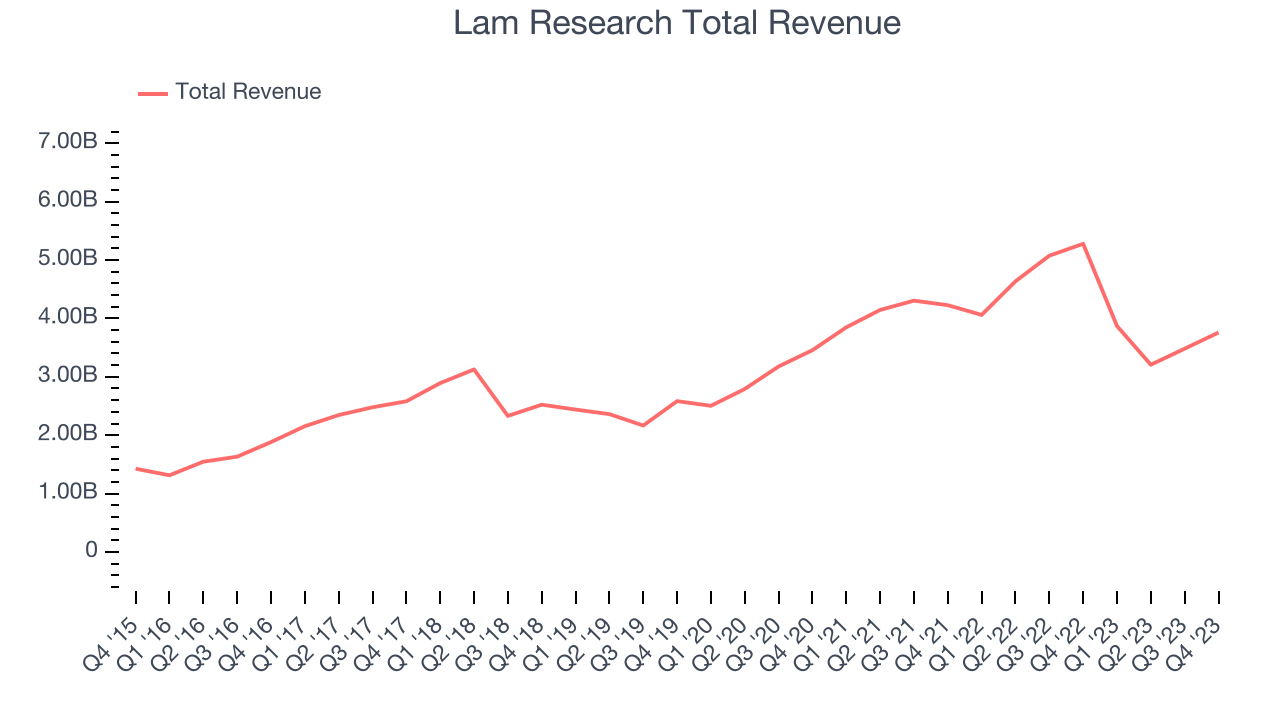
Even though Lam Research surpassed analysts' revenue estimates, this was a slow quarter for the company as its revenue dropped 28.8% year on year. This could mean that the current downcycle is deepening.
Lam Research looks like it's on the cusp of a rebound, as it's guiding to 4.6% year-on-year revenue growth for the next quarter. Analysts seem to agree as consesus estimates call for 10.3% growth over the next 12 months.
Product Demand & Outstanding Inventory
Days Inventory Outstanding (DIO) is an important metric for chipmakers, as it reflects a business' capital intensity and the cyclical nature of semiconductor supply and demand. In a tight supply environment, inventories tend to be stable, allowing chipmakers to exert pricing power. Steadily increasing DIO can be a warning sign that demand is weak, and if inventories continue to rise, the company may have to downsize production.
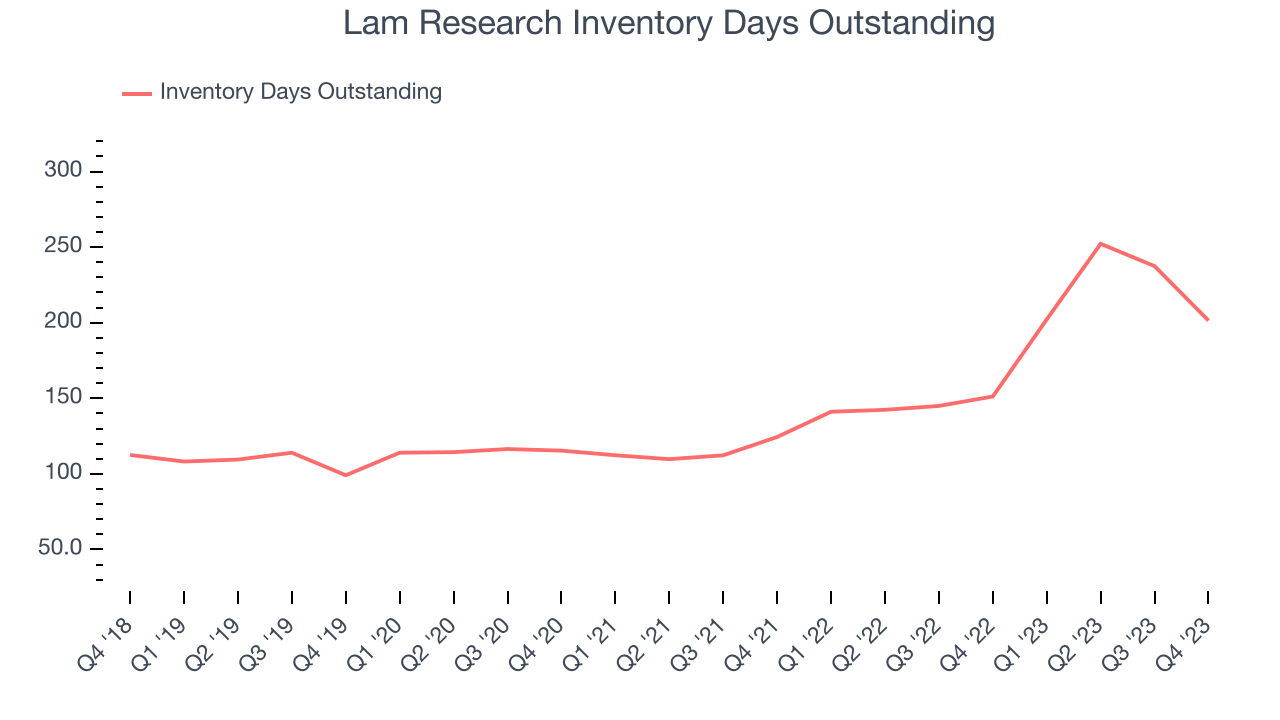
This quarter, Lam Research's DIO came in at 201, which is 60 days above its five-year average. These numbers suggest that despite the recent decrease, the company's inventory levels are higher than what we've seen in the past.
Pricing Power
In the semiconductor industry, a company's gross profit margin is a critical metric to track because it sheds light on its pricing power, complexity of products, and ability to procure raw materials, equipment, and labor. Lam Research's gross profit margin, which shows how much money the company gets to keep after paying key materials, input, and manufacturing costs, came in at 46.8% in Q2, up 1.7 percentage points year on year.
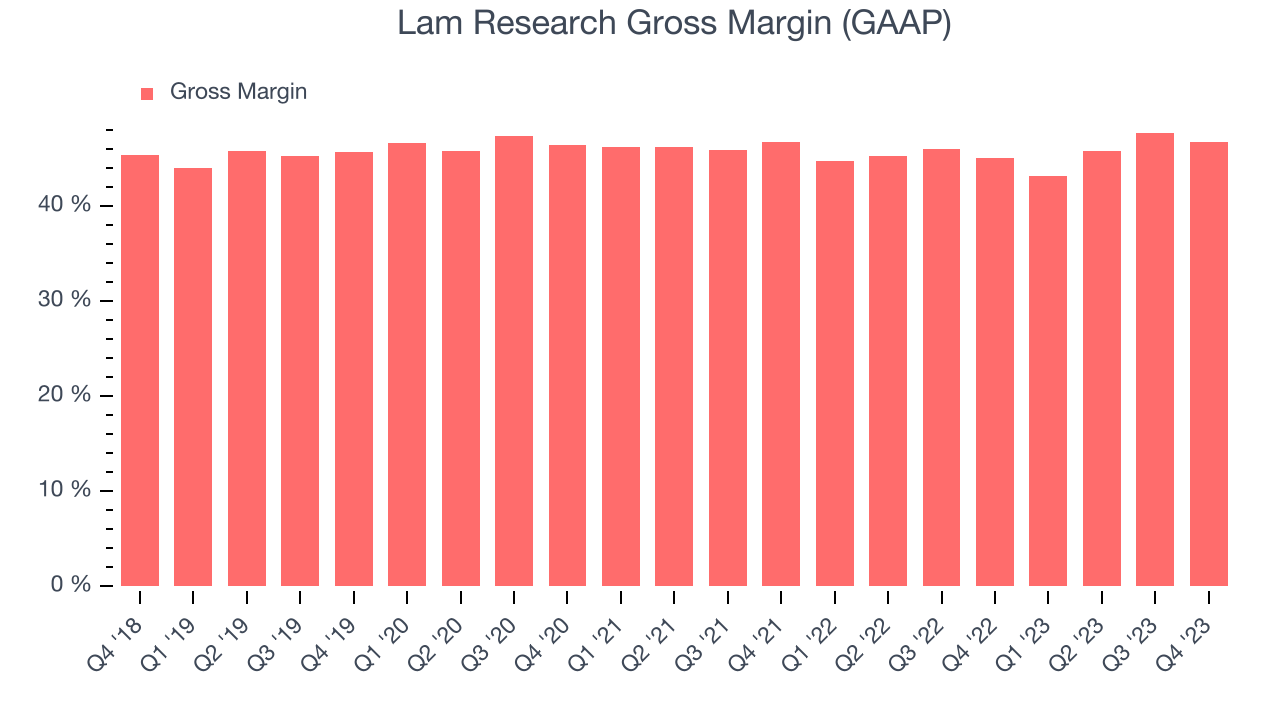
Lam Research's gross margins have been trending up over the last 12 months, averaging 45.9%. This is a welcome development, as Lam Research's margins are slightly below the peer group average and rising margins could suggest improved demand and pricing power.
Profitability
Lam Research reported an operating margin of 30% in Q2, down 2.1 percentage points year on year. Operating margins are one of the best measures of profitability because they tell us how much money a company takes home after manufacturing its products, marketing and selling them, and, importantly, keeping them relevant through research and development.
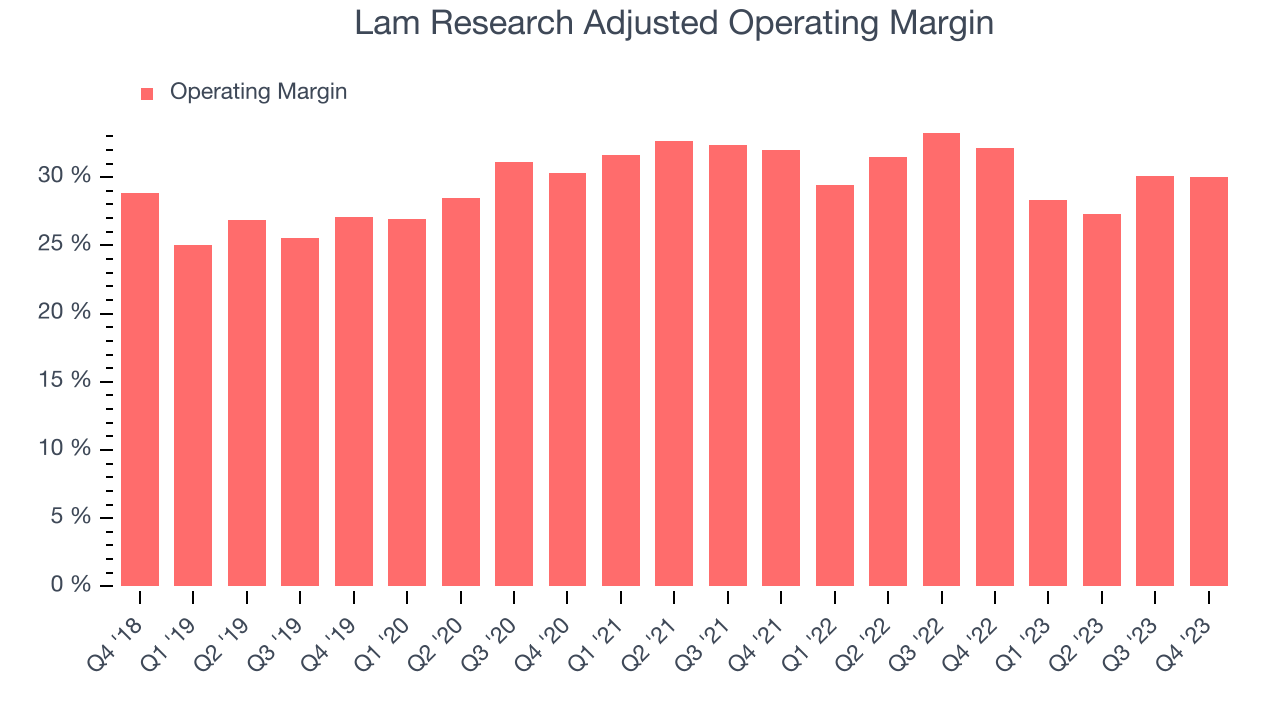
Lam Research's operating margins have been trending down over the last year, averaging 28.9%. The company's profitability is in line with the broader semiconductor industry and it's working to appropriately manage its operating expenses.
Earnings, Cash & Competitive Moat
Analysts covering Lam Research expect earnings per share to grow 8.8% over the next 12 months, although estimates will likely change after earnings.
Although earnings are important, we believe cash is king because you can't use accounting profits to pay the bills. Lam Research's free cash flow came in at $1.34 billion in Q2, up 37% year on year.
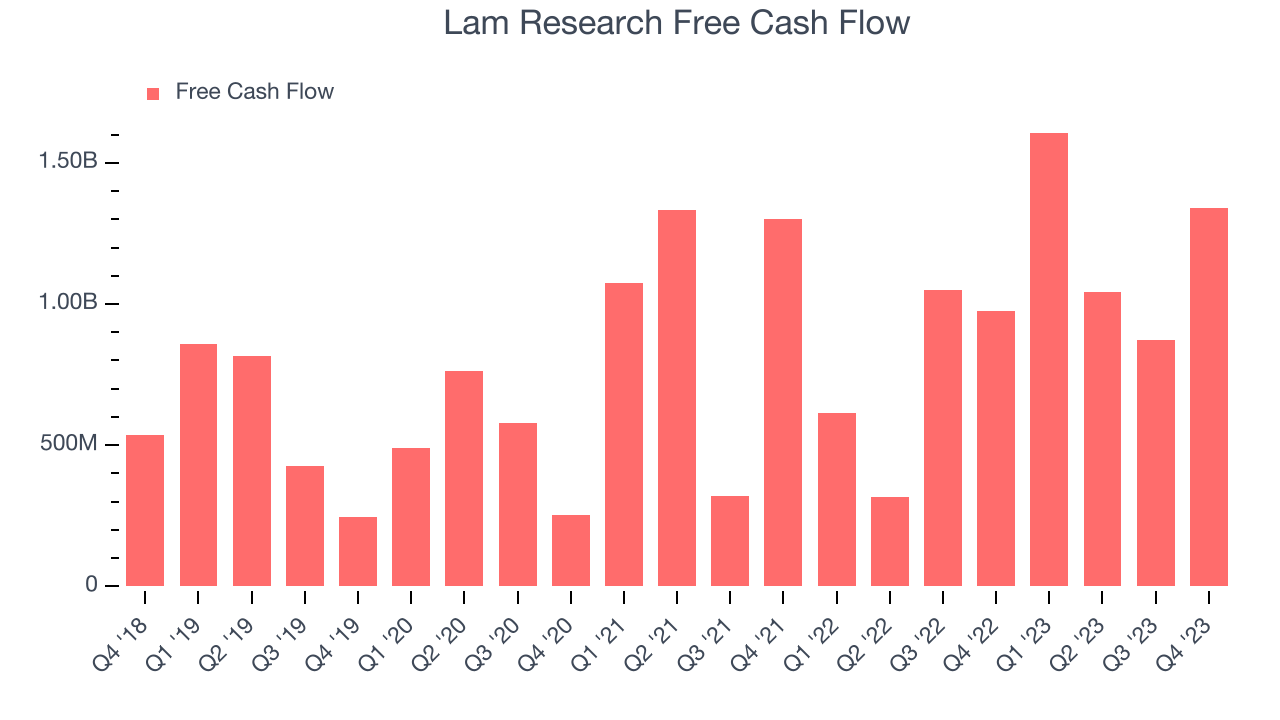
As you can see above, Lam Research produced $4.86 billion in free cash flow over the last 12 months, an eye-popping 33.7% of revenue. This is a great result; Lam Research's free cash flow conversion places it among the best semiconductor companies and, if sustainable, puts the company in an advantageous position to invest in new products while remaining resilient during industry downturns.
Key Takeaways from Lam Research's Q1 Results
Sporting a market capitalization of $85.9 billion, more than $5.16 billion in cash on hand, and positive free cash flow over the last 12 months, we believe that Lam Research is attractively positioned to invest in growth.
We were impressed by how significantly Lam Research blew past analysts' EPS expectations this quarter, driven by better-than-expected systems and customer support revenue. We were also glad its inventory levels shrunk. On the other hand, its operating margin declined. Overall, we think this was a strong quarter that should satisfy shareholders. The stock, however, is down 3.5% immediately after reporting and currently trades at $619.98 per share.
Return on Invested Capital (ROIC)
EPS growth informs us whether a company's revenue growth was profitable. But was it capital-efficient? For example, if two companies had the same EPS growth, we’d prefer the one putting up those numbers with lower capital requirements (usually in the form of balance sheet debt and equity).
Enter ROIC, a pivotal metric showing how much operating profit a company generates relative to the capital it's invested in the business. ROIC not only gauges a company's ability to grow profits but also sheds light on a management team's ability to allocate its limited resources.
Lam Research's five-year average ROIC was 62.7%, placing it among the best semiconductor companies. Just as you’d like your investment dollars to generate returns, Lam Research's invested capital has produced excellent profits. The trend in its ROIC, however, is often what surprises the market and drives the stock price. Lam Research's ROIC has averaged 6.1 percentage point increases each year. We think Lam Research is a good business, and its rising returns gives us more confidence in the company’s trajectory. It could suggest its competitive advantage or profitable investment opportunities are growing.
Key Takeaways from Lam Research's Q2 Results
We were impressed by Lam Research's strong improvement in inventory levels and EPS beat. We were also excited its free cash flow blew past Wall Street's estimates. The company noted that elevated demand for AI-driven solutions has been a revenue tailwind. Overall, we think this was a strong quarter that should satisfy shareholders. The stock is flat after reporting and currently trades at $844 per share.
Is Now The Time?
When considering an investment in Lam Research, investors should take into account its valuation and business qualities as well as what's happened in the latest quarter.
We think Lam Research is a good business. Although its revenue growth has been weak over the last three years with analysts expecting growth to slow from here, its powerful free cash generation enables it to sustainably invest in growth initiatives while maintaining an ample cash cushion. And while its gross margins are weaker than its semiconductor peers we look at, its stellar ROIC suggests it has been a well-run company historically.
Lam Research's price-to-earnings ratio based on the next 12 months is 28.6x. There's definitely a lot of things to like about Lam Research and looking at the semiconductors landscape right now, it seems that the company trades at a pretty interesting price point.
To get the best start with StockStory check out our most recent Stock picks, and then sign up to our earnings alerts by adding companies to your watchlist here. We typically have the quarterly earnings results analyzed within seconds of the data being released, and especially for the companies reporting pre-market, this often gives investors the chance to react to the results before the market has fully absorbed the information.
